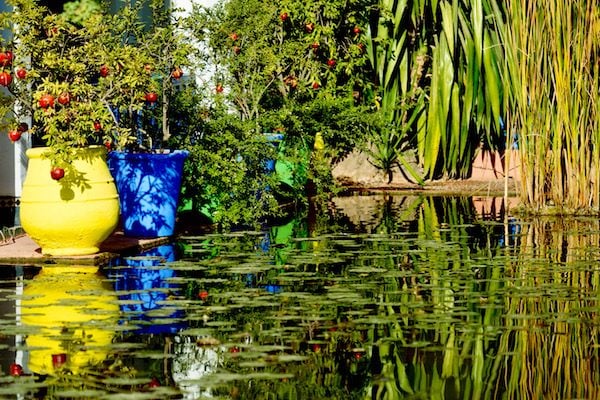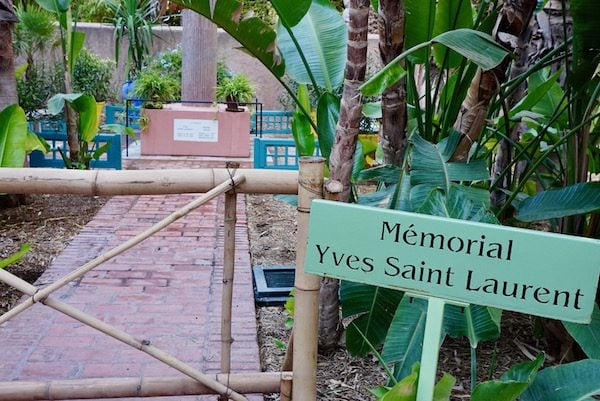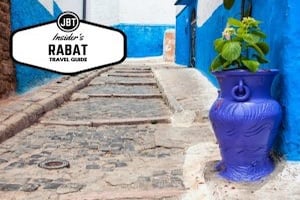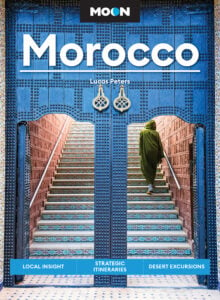Of all the gardens the world over, the Majorelle Garden (Le Jardin Majorelle) in Marrakesh is one of the most exquisite. Located outside of the historic old medina, this veritable paradise blends Art Deco charm with a modern take on the traditional Islamic garden. If you were going to visit one garden in Morocco, the Majorelle Garden would be the one.

The History of the Majorelle Garden
In 1919, Jacques Majorelle, an expatriate French painter, settled in Morocco. He originally made this decision for health reasons. However, in 1922, he purchased about four acres on what was then the outskirts of the French Gueliz neighborhood. Over the years, he expanded his land holdings and labored in a vast garden where he could dabble in his hobby of growing exotic plants and trees.
Majorelle was a known plantoholic and collected plants from North and South Africa as well as Asia and the Americas to fill the garden with species that had bold forms and would thrive in the dry semiarid clime of Marrakesh. Various species of cacti, both exotic and indigenous, as well as towering banana and poplar trees.

When Jaques Majorelle first created his garden, he approached it as he did his art. For forty years he worked in his garden, composing and building, thinking of the earth and light and how the architectural elements he introduced — such as raised pools and tiled pathways — intersected and gave importance the nature flowering around. Many of these elements were inspired by the traditional Islamic gardens found throughout Marrakesh. In these gardens, inspired from Quranic verses and the ideas of the gardens of heaven, water is of utmost importance. If you’re visiting the old city of Marrakesh, you can find a wonderful example of this type of garden at the not-so Secret Garden located right in the medina.
As a backdrop to the garden, the Majorelle Blue (a trademarked hue like cobalt, though richer and deeper) provides contrast. Shades of green, terracotta, deep reds, and chrome yellows set the scene to this masterpiece. In fact, it is now thought that the greatest artwork Majorelle ever produced was his garden. A popular sentiment that recalls fellow French artist Claude Monet and his lovely gardens at Giverny outside of Paris.
Jacques Majorelle first opened his gardens to the public in 1947. Whatever money he earned from admissions, he poured back into his garden. It was an obsession of his. Sadly, when he died in 1962, the gardens and home fell into disrepair.
For years after Majorelle’s death the gardens lay dormant, and then altogether forgotten.
It wasn’t until fashion icon Yves Saint-Laurent, with his partner Pierre Bergé, rediscovered the gardens in 1980 that they were rescued from a likely future of becoming yet another apartment complex in the burgeoning “new city” of Marrakesh. Together, Saint-Laurent and Bergé spearheaded major restorations of the grounds. Along the way, they worked with renowned garden designer Madison Cox to tame the wild garden, restore its architecture, and evolve it into what became their private retreat.

The Majorelle Garden Today
In 2001, Saint-Laurent and Bergé created a foundation to ensure the protection and maintenance of the garden for generations to come. When Yves Saint-Laurent passed in 2008, his ashes were spread through the garden. The gardens have been managed by the Foundation Jardin Majorelle, a registered NGO, since 2011. In 2017, Pierre Bergé died. There is a memorial to Bergé and Saint-Laurent now found along the walk through the public gardens.

Today, the grounds are wonderfully maintained. Newly constructed walkways, fountains and shady gazebos have added to the tranquility of the gardens. Here, you will find hundreds of exotic plants and peacefully shaded grounds, the Majorelle Garden provides a nice reprieve from the bustling souks and general hubbub of Marrakesh.
The impressive gardens house a collection of exotic bamboo, cacti and palms from around the world. Birders and nature lovers would also be happy to know that the garden provides a much-needed haven for various species of local birds like storks, kestrels and flycatchers.
The Pierre Berge Museum of Berber Art in the Majorelle Garden
Beyond the majestic gardens, the property has evolved to now include the Pierre Bergé Museum of Berber Art (Musée Pierre Bergé des Arts Berbères). As the name suggests, this museum has a focused collection celebrating the Amazigh (commonly known as the Berbers) of Morocco. The Amazigh are the indigenous peoples of Morocco. Not only did Bergé have an enormous respect for them, he was inspired by them in his own life as well. Since Bergé first found himself in Morocco back in 1966, he remained fascinated by their art and culture. He collected a wealth of Amazigh art from nearly every corner of the country.
The Berbers have always been rightly proud of their culture, and have not ceased to reclaim their identity in spite of the vicissitudes they have faced. — Pierre Bergé

Bergé created the museum dedicated to Amazigh art and culture in 2011. You’ll find it in the gardens housed in a cubist building originally designed by the architect Paul Sinoir in the 1930s. The museum has flourished ever since. In the collection, you can discover over 600 discrete objects from all around Morocco. North African textiles, jewelry, carpets and other treasures from the indigenous people of Morocco.
How to Visit the Majorelle Garden
The gardens are open daily throughout the year, though the gardens can be closed for major holidays or private events. It is best to reserve tickets at least 24 hours in advance. If you’re spending a few days in Marrakesh, you will want to give yourself about half a day to visit the gardens and museum, though for some, an hour or two is sufficient.
On a tour with Journey Beyond Travel, we can take care of your reservations and make sure that you find your way to-and-from the gardens
If you are traveling on your own steam, taxis know exactly where to go. Finding a taxi after you leave the gardens is rarely a problem. For tickets, visit the Majorelle Garden website: https://www.jardinmajorelle.com/en/
In general, you will want to make sure you visit the gardens as early in the day as possible.
As a last note, while you are in the neighborhood, you might want to make time to visit the Yves Saint-Laurent Museum located right next door to the gardens. There is a discount if you purchase tickets together with the Majorelle Garden and Berber Museum.
About the Author
 Text and photos by award-winning writer, photographer, and Morocco expert, Lucas Peters. After spending years traveling to the distant corners of Morocco and writing about his adventures, Lucas penned the 1st and 2nd editions of the best-selling guidebook Moon Guidebooks: Morocco as well as Marrakesh and Beyond published by Hachette. He edited and contributed to the Our Morocco anthology and helps the travelers of Journey Beyond Travel experience the adventure of a lifetime. He lives in Tangier with his family.
Text and photos by award-winning writer, photographer, and Morocco expert, Lucas Peters. After spending years traveling to the distant corners of Morocco and writing about his adventures, Lucas penned the 1st and 2nd editions of the best-selling guidebook Moon Guidebooks: Morocco as well as Marrakesh and Beyond published by Hachette. He edited and contributed to the Our Morocco anthology and helps the travelers of Journey Beyond Travel experience the adventure of a lifetime. He lives in Tangier with his family.









